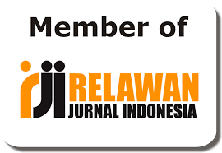Interest and learning achievement of mathematics on blended learning in West Papua
Minat dan hasil belajar pada blended learning di Papua Barat
Abstrak
The purpose of this research is to find out the interests and learning outcomes of students through blended learning. This research is quantitative and descriptive. The subjects of this study were thirty-one students in the second semester of the Mathematics Education Study Program at Muhammadiyah University of Education, West Papua, Indonesia. Data collection techniques were carried out by tests and non-tests, and the instruments used were interest in learning questionnaires and learning achievement tests, as well as documentation. Learning outcomes in general indicate that the average student score is seventy-six, which indicates that the interpretation of student scores is "AB," or 3.50, and the average indicator of competency achievement in the overall integral calculus course is in the high category. The results of the total analysis of the interest in learning questionnaire obtained 90.91% results in the remarkably high category. The average percentage of each interest indicator is in the "very high" category range. The results of the study show that blended learning can arouse students' interest and attention and have a positive impact on learning outcomes, so when applying blended learning, all supporting components must be considered to create an optimal learning experience.
##plugins.generic.usageStats.downloads##
Referensi
Amenduni, F., & Ligorio, M. B. (2022). Blended Learning and Teaching in Higher Education: An International Perspective. In Education Sciences (Vol. 12, Issue 2). https://doi.org/10.3390/educsci12020129
Arikunto, S. (2013). Metode Penelitian Pendidikan. Alfabeta.
Bent, M., Velazquez-Godinez, E., & de Jong, F. (2021). Becoming an expert teacher: Assessing expertise growth in peer feedback video recordings by lexical analysis. Education Sciences, 11(11). https://doi.org/10.3390/educsci11110665
Bryan, A., & Volchenkova, K. N. (2016). Blended Learning: Definition, Models, Implications for Higher Education. Bulletin of the South Ural State University Series “Education. Education Sciences,” 8(2), 24–30. https://doi.org/10.14529/ped160204
Crawford, R., & Jenkins, L. (2017). Blended learning and team teaching: Adapting pedagogy in response to the changing digital tertiary environment. Australasian Journal of Educational Technology, 33(2). https://doi.org/10.14742/ajet.2924
Elliott, S. N. (2001). Educational psycology: effective teachin. effective learning (3rd ed). McGraw-Hill.
Irwan, Angraini, R., & Tiara, M. (2020). Analysis of Student Interest on Blended Learning. https://doi.org/10.2991/assehr.k.200803.041
Kurnia, S., Hidayat, S., & Wardhani, S. (2021). Analisis Minat dan Hasil Belajar Biologi Siswa pada Pembelajaran Daring di SMA Negeri Purwodadi Kabupaten Musi Rawas. BIODIK, 7(4). https://doi.org/10.22437/bio.v7i4.14489
Mardapi, D. (2008). Teknik penyusunan instrumen tes dan non tes. Mitra Cendekia Press.
Nasution, F. H., Hasibuan, I. S., & Lubis, J. A. (2017). Peningkatan Hasil Belajar Biologi Siswa Melalui Penerapan Model Pembelajaran Kooperatif Tipe Group Investigation (GI). PeTeKa, 1(1). https://doi.org/10.31604/ptk.v1i1.28-33
Nitko, A. J., & Brookhart, S. M. (2014). Educational Assessment of Students Sixth Edition. In Pearson New International Edition.
Ritella, G., & Loperfido, F. F. (2021). Students’ self-organization of the learning environment during a blended knowledge creation course. Education Sciences, 11(10). https://doi.org/10.3390/educsci11100580
Ross, B., & Gage, K. (2006). Global perspectives on blended learning: Insight from WebCT and our customers in higher education. In The handbook of blended learning: Global perspectives, local designs.
Sansone, N., Cesareni, D., Bortolotti, I., & McLay, K. F. (2021). The designing and re-designing of a blended university course based on the trialogical learning approach. Education Sciences, 11(10). https://doi.org/10.3390/educsci11100591
Savickas, M. L., & Spokane, A. R. (1999). Vocational interests: meaning measurement and counseling use. Davies-Black Publishing.
Schunk, D., Meece, J., & Pintrich, P. (2014). Pearson New International Edition: Motivation in Education Theory, Research, and Applications. In British Library Cataloguing-in-Publication Data.
Seifert, K., & Sutton, R. (2009). Educational psychology (2nd ed). Jacobs Fondation.
Sirait, E. D. (2016). Pengaruh Minat Belajar Terhadap Prestasi Belajar Matematika. Formatif: Jurnal Ilmiah Pendidikan MIPA, 6(1). https://doi.org/10.30998/formatif.v6i1.750
So, H. J., & Bonk, C. J. (2010). Examining the roles of blended learning approaches in computer-supported collaborative learning (CSCL) environments: A delphi study. Educational Technology and Society, 13(3).
Soliman, D., Costa, S., & Scardamalia, M. (2021). Knowledge building in online mode: Insights and reflections. Education Sciences, 11(8). https://doi.org/10.3390/educsci11080425
Stahl, G. (2021). Redesigning mathematical curriculum for blended learning. Education Sciences, 11(4). https://doi.org/10.3390/educsci11040165
Sugiyono. (2018). Metode Penelitian Kuantitatif ,Kualitatif, dan R&D. Alfabeta.
Wicaksana, G. A., Nurhayati, S., & Cahyono, E. (2013). Efektifitas Media E-Lerning Berbasis Chemo-Edutainment Terhadap Hasil Belajar Hidrokarbon Dan Minyak Bumi Kelas X. Journal of Chemisry in Education, Vo 2 No 1.
Wichadee, S. (2017). A development of the blended learning model using edmodo for maximizing students’ oral proficiency and motivation. International Journal of Emerging Technologies in Learning, 12(2). https://doi.org/10.3991/ijet. v12i02.6324





















